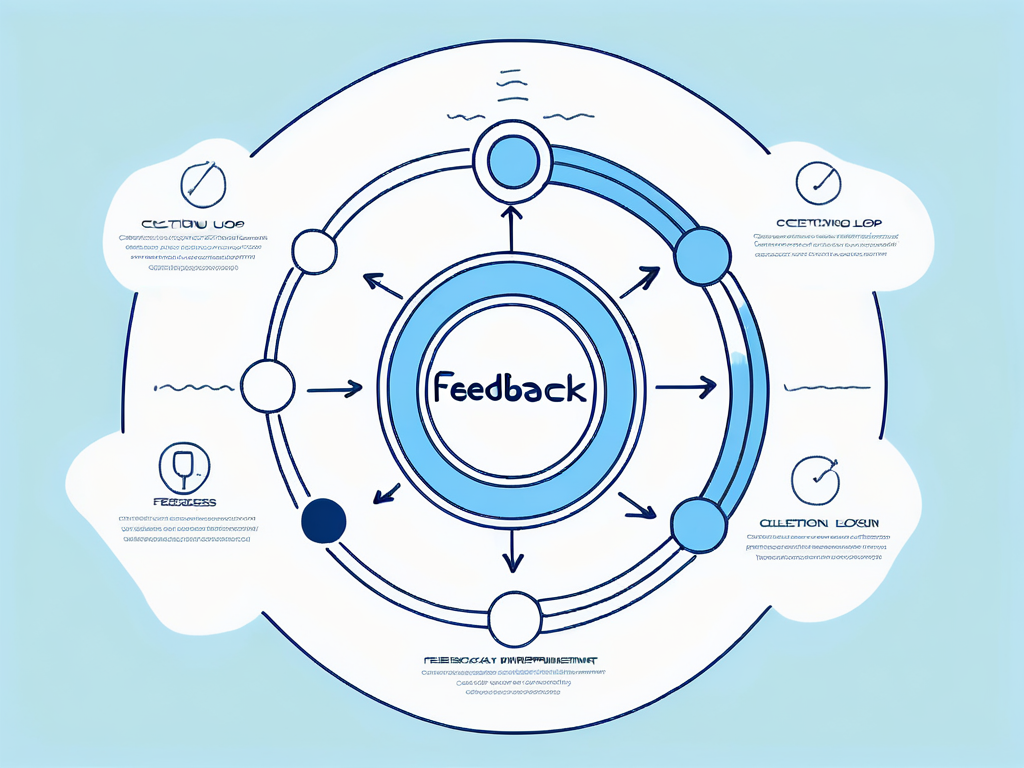· Xergio · tutorials · 10 min read
The Feedback Loop How Feedback Surveys Drive Continuous Improvement in Business
Dive into the power of feedback surveys for continuous improvement. Overcome Scrum adoption challenges with proven strategies.

In today’s fast-paced business landscape, companies are constantly seeking ways to improve their operations and stay ahead of the competition. One powerful tool that drives continuous improvement is the feedback loop. By collecting valuable feedback from customers, employees, and stakeholders, businesses can identify areas of improvement and implement changes that lead to growth and success.
Understanding the Concept of a Feedback Loop
At its core, a feedback loop is a cyclical process that involves collecting feedback, analyzing it, implementing changes based on the feedback, and then collecting more feedback to evaluate the effectiveness of those changes. It is a continuous cycle that helps businesses adapt and evolve to meet the changing needs and expectations of their target audience.
 Feedback loops are not only valuable in the business world but are also prevalent in various other fields, such as biology, engineering, and even personal development. In biology, for example, feedback loops regulate processes like body temperature and hormone levels to maintain homeostasis. Understanding the concept of feedback loops can provide insights into how systems function and how they can be optimized for better performance.
Feedback loops are not only valuable in the business world but are also prevalent in various other fields, such as biology, engineering, and even personal development. In biology, for example, feedback loops regulate processes like body temperature and hormone levels to maintain homeostasis. Understanding the concept of feedback loops can provide insights into how systems function and how they can be optimized for better performance.
The Importance of Feedback in Business
Feedback plays a crucial role in the success of any business. It provides valuable insights into what is working well and what needs improvement. By listening to feedback, businesses can better understand their customers’ experiences, identify pain points, and make informed decisions to enhance their products, services, and overall customer satisfaction.
Moreover, feedback not only benefits the business but also fosters a sense of engagement and loyalty among customers. When customers see that their feedback is being heard and acted upon, it creates a positive relationship between the business and its clientele. This, in turn, can lead to increased customer retention and advocacy, ultimately contributing to the growth and sustainability of the business.
The Mechanics of a Feedback Loop
In order to effectively implement a feedback loop, businesses must have a clear process in place. This typically involves creating mechanisms for collecting feedback, such as surveys, feedback forms, or customer review platforms. Once the feedback is collected, it is then analyzed, and actionable insights are extracted. These insights are used to make strategic decisions and implement changes within the organization. The cycle is repeated regularly to ensure continuous improvement.
Additionally, businesses can leverage technology to streamline the feedback loop process. With the advancement of artificial intelligence and data analytics, companies can now gather and analyze feedback on a larger scale and with more precision. This data-driven approach not only saves time and resources but also allows for more targeted and effective decision-making based on real-time feedback trends.
The Role of Surveys in Gathering Feedback
Surveys are a common and effective tool for gathering feedback from customers, employees, and other stakeholders. They provide a structured way to collect data and insights, allowing businesses to quantify feedback and identify trends or patterns. Surveys can be customized to target specific areas of interest and can be conducted through various channels, including online platforms, email campaigns, or even in-person interactions.

Different Types of Feedback Surveys
There are several types of feedback surveys that businesses can utilize, depending on their specific goals and target audience. Customer satisfaction surveys, for example, measure overall customer experience and satisfaction levels. Employee engagement surveys assess employees’ attitudes, motivations, and overall job satisfaction. Market research surveys capture insights about the target market and their preferences. By choosing the right type of survey, businesses can gather targeted feedback that aligns with their objectives.
Designing Effective Feedback Surveys
Designing effective feedback surveys requires careful consideration of the questions asked, the survey format, and the target audience. Surveys should be concise, easy to understand, and relevant to the respondent. It is important to use a combination of closed-ended and open-ended questions to gather both quantitative and qualitative feedback. Additionally, surveys should be mobile-friendly to accommodate the increasing number of respondents accessing them through mobile devices.
When designing a feedback survey, it is crucial to think about the order in which questions are presented. Starting with more general questions and gradually moving towards more specific ones can help respondents ease into the survey and provide more thoughtful responses. Furthermore, including a progress bar or indicator can give respondents a sense of how much longer the survey will take, reducing the likelihood of dropouts.
Another important aspect of designing effective feedback surveys is ensuring that the questions are unbiased and neutral. Using leading or loaded questions can skew the results and compromise the validity of the feedback. It is essential to use clear and neutral language that does not influence respondents’ answers.
Analyzing Feedback for Business Improvement
Collecting feedback is only the first step in the feedback loop. The true value lies in analyzing the feedback and extracting actionable insights that can drive business improvement. Effective analysis enables businesses to identify themes, trends, and areas of improvement, allowing them to take targeted actions that address specific issues or enhance their overall performance.
 Furthermore, analyzing feedback goes beyond just looking at the numbers. It involves delving deep into the qualitative feedback provided by customers, employees, or other stakeholders. Understanding the underlying reasons behind the feedback is crucial in order to make informed decisions and implement meaningful changes. By taking a holistic approach to feedback analysis, businesses can gain a comprehensive understanding of their strengths and weaknesses.
Furthermore, analyzing feedback goes beyond just looking at the numbers. It involves delving deep into the qualitative feedback provided by customers, employees, or other stakeholders. Understanding the underlying reasons behind the feedback is crucial in order to make informed decisions and implement meaningful changes. By taking a holistic approach to feedback analysis, businesses can gain a comprehensive understanding of their strengths and weaknesses.
Interpreting Survey Results
Interpreting survey results involves more than just examining the data. It requires a deep understanding of the context, the target audience, and the objectives of the survey. Businesses must analyze the results in relation to their goals and identify key takeaways. Charts, graphs, and other visual representations can be used to simplify complex data and highlight important findings.
Moreover, conducting segmentation analysis can provide valuable insights by breaking down survey results based on different demographics, behaviors, or other relevant factors. This approach can reveal patterns that may not be apparent when looking at the data as a whole, helping businesses tailor their strategies to specific audience segments.
Identifying Areas of Improvement
Once survey results have been analyzed, businesses can identify specific areas that require improvement. This may include product features, customer service practices, internal processes, or any other aspect of the business that is not meeting expectations. By pinpointing areas of improvement, businesses can prioritize their efforts and allocate resources effectively to drive positive change.
In addition, leveraging benchmarking data can provide valuable context for identifying areas of improvement. Comparing survey results against industry benchmarks or competitors’ performance can offer insights into where a business stands relative to others in the market. This external perspective can help businesses set realistic improvement goals and stay competitive in their industry.
Implementing Changes Based on Feedback
Implementing changes based on feedback is a critical step in the feedback loop. It is where businesses turn insights into action, making tangible improvements that positively impact their operations, products, and services.
When businesses receive feedback, whether from customers, employees, or other stakeholders, it provides them with valuable information that can drive innovation and growth. By analyzing this feedback, businesses can identify areas for improvement and develop strategies to address them. Implementing changes based on feedback not only demonstrates a commitment to listening and responding to stakeholders but also fosters a culture of continuous improvement within the organization.
Strategies for Effective Implementation
Implementing changes effectively requires a well-thought-out strategy. It is important to involve key stakeholders, including employees and customers, in the decision-making process. Clear communication and transparency are essential to gaining buy-in and ensuring that everyone understands the rationale behind the changes. Businesses should also allocate sufficient resources, monitor progress, and provide training or support when needed.
Furthermore, businesses can leverage technology to streamline the implementation process. Project management tools, communication platforms, and data analytics software can help organizations track the progress of changes, communicate updates to stakeholders, and measure the impact of implemented initiatives. By embracing digital solutions, businesses can enhance their efficiency and effectiveness in implementing feedback-driven changes.
Monitoring Changes and Measuring Impact
Once changes have been implemented, businesses need to monitor their impact and measure the results. This is where the feedback loop comes full circle. By collecting additional feedback and comparing it to the pre-change feedback, businesses can assess the effectiveness of the implemented changes. This ongoing monitoring allows for continuous adjustment and ensures that businesses stay responsive to feedback and remain on the path of improvement.
Moreover, measuring the impact of changes goes beyond quantitative metrics. Qualitative feedback, such as customer testimonials, employee satisfaction surveys, and market perception studies, can provide valuable insights into the broader implications of implemented changes. By taking a holistic approach to measuring impact, businesses can gain a comprehensive understanding of how feedback-driven changes have influenced various aspects of their operations and relationships.
Maintaining a Continuous Feedback Loop
Maintaining a continuous feedback loop is essential for long-term business success. By regularly collecting feedback, implementing changes, and monitoring their impact, businesses can create a culture of continuous improvement and innovation.
Regularly Conducting Feedback Surveys
Regularly conducting feedback surveys is a key component of maintaining a feedback loop. Businesses should establish a schedule for survey administration to ensure a consistent flow of feedback. This schedule can be based on specific milestones, such as after a product launch, or on a regular basis, such as quarterly or annually. The frequency and timing of surveys should align with the nature of the business and the expected rate of change.
When designing feedback surveys, it is important to consider the types of questions being asked. Open-ended questions can provide valuable qualitative insights, allowing respondents to express their thoughts and ideas freely. On the other hand, closed-ended questions with predefined answer options can help gather quantitative data, making it easier to analyze and compare responses. By using a combination of both types of questions, businesses can gain a comprehensive understanding of their customers’ experiences and preferences.
Adapting to Feedback and Evolving Business Practices
Feedback should not be viewed as a one-time event or a box to be checked. It is an ongoing dialogue between the business and its stakeholders. Businesses must be receptive to feedback, willing to adapt, and open to evolving their practices based on the insights gained.
One way to effectively adapt to feedback is by establishing a cross-functional feedback review team. This team can consist of representatives from different departments within the organization, bringing diverse perspectives and expertise to the table. By collaboratively reviewing and analyzing feedback, businesses can identify patterns, trends, and areas for improvement. This collaborative approach not only fosters a sense of ownership and accountability but also encourages innovation and creativity in finding solutions.
Furthermore, businesses should consider implementing a feedback tracking system to monitor the impact of changes made based on feedback. This system can help identify the effectiveness of implemented solutions, track progress over time, and identify any emerging trends or issues that require attention. By continuously monitoring the impact of feedback-driven changes, businesses can ensure that they are on the right track towards improvement and innovation.
In conclusion, the feedback loop is a powerful tool that drives continuous improvement in business. By understanding the concept of a feedback loop, the role of surveys in gathering feedback, analyzing feedback for business improvement, implementing changes based on feedback, and maintaining a continuous feedback loop, businesses can create a culture of growth and innovation. By actively seeking feedback and leveraging insights gained, businesses can stay responsive to customer needs, enhance their operations, and ultimately achieve long-term success.





